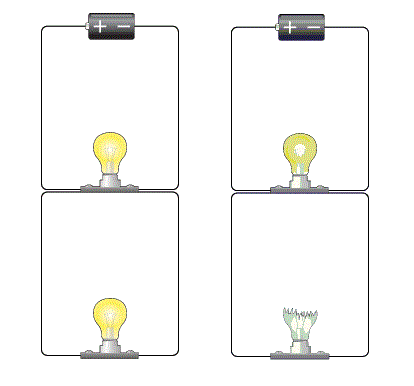Series Circuits
Series circuits are sometimes called current-couple or daisy chain-coupled. The current in a series circuit goes through every components in the circuit. Therefore, all of the components in a series connection carry the same current. there is only one path in a series circuit in which the current can flow. A simple circuit has one power source and one output device. Simple circuit are limited in the amount of power that can be provided. It uses a single path to connect all devices.
Simple Series Circuit
Advantage and Disadvantage
An advantage of a series circuit is that you can add more power devices, such as more batteries, and increase the force of the output. This will give your more power.
One disadvantage is that as you add output devices, such as light bulbs, you increase the resistance and the bulbs do not shine as brightly. Another important disadvantage is that if one output devices stops working, all the other output devices will stop working too. This is because all of the power and output devices are connected in a straight line. When one fails, you have broken circuit and nothing will work.
Parallel Circuit
If two or more components are connected in parallel they have the same potential difference (voltage) across their ends. The potential differences across the components are the same magnitude, and they also have identical polarities. The same voltage is applicable to all circuit components connected in parallel. The total current is the sum of the currents through the individual components, in accordance with Kirchoff's current law.
Simple Parallel Circuit
Advantage and Disadvantage
Parallel circuit also have more than one power source or output device. They use more than one path for the electricity to flow. You can think of a parallel device as having a main line going out from the power source and another main line going back to it. The output devices use branch line to connect each of their positive poles to one main line and their negative poles to the other main line. The advantage of a parallel circuit is that if one of the output devices burns out, then only that device stops working. The disadvantage is that if you have multiple power source, the power stays at the same voltage as that of the single power source. But in parallel circuit increasing the number of output devices does not increase the resistance the way it does in series circuits.
Learnings:
In this topic, we discuss the series and parallel circuit. I've learned that the series circuit has only one path to follow. If the circuit is open, or broken, at any point, current stops flowing through every part of the circuit. For example, strings of tree light used to be wired in series. When one bulb burned out, the circuit was broken. As a result, the current would stop and all of the bulb would go out. While in the parallel circuit even if one of the branches of the circuit is broken, current still flows though the rest of the circuit.
“Enthusiasm is the electricity of life. How do you get it? You act enthusiastic until you make it a habit.”




No comments:
Post a Comment